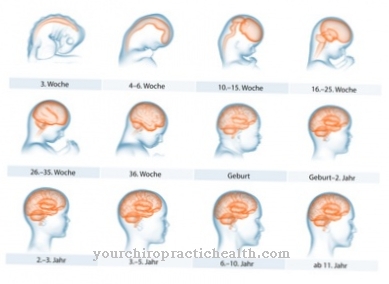The sensation is a preliminary stage of perception and corresponds to the primary sensory impression made by the neuroanatomical sense organs. All processing processes, especially the emotional evaluation of the sensory impression, turn the sensation into perception in the brain.
What is the sensation?

Human perception is a highly complex process that consists of many individual processes. In addition to alertness, selective attention and motivation, the feeling component is one of the most relevant terms within the perception process. The emotional and intellectual perception processing steps modify what is perceived and at the same time are influenced back by the perception process.
At the beginning of perception is sensation or sensation. The sense organs receive stimuli. The sensation is a preliminary stage of the actual perception. Only through the intellectual and emotional steps is the perception actually experienced instead of just felt.
Conscious perception takes place in the cerebral cortex and is sometimes most strongly controlled by the limbic system. The limbic system corresponds to the central location for human emotions. How different people perceive a certain perception can vary greatly. The limbic system controls the innate and acquired behavior of humans and is considered to be the place of origin of motivation, drives and emotions such as fear, anger or joy and displeasure.
The entire learning experience of a person resides in the limbic system. That two people perceive situations differently is due to this context. A perception is assessed subjectively by the limbic system and on the basis of individual previous experience. These evaluation processes result in a certain experience of what is perceived. This experience distinguishes perception from sensory perception, which corresponds exclusively to the primary sensory impression of the organs.
Function & task
The sensation of perception is the totality of perception minus the processes of intellectual and emotional processing. Hardly anything subconsciously influences the human being as strongly as the emotional instructions of the limbic system. The limbic system is significantly involved in perceptual processes and thus takes care of, for example, the selection, processing, evaluation and storage of any information from the sensory organs.
Countless stimuli constantly flow into people. From the point of view of the brain, these stimuli represent a vast amount of information. The fact that people nevertheless filter out the stimuli that are currently relevant and appropriate to their mood from the abundance of information is partly thanks to the limbic system. The limbic system prefers and disadvantages certain stimuli. Information that has an emotional content is particularly preferred.
Emotions stimulate the limbic system. All stimuli in connection with an emotional image penetrate the filter more easily and thus reach consciousness more easily. The sensation of perception in the sense of emotional participation in what is perceived is an important key for the ability to perceive.
The emotional content of a perception in connection with the olfactory system, responsible for the sense of smell, plays a special role. Smell perceptions sometimes have the strongest emotional component. The olfactory bulb is connected to the amygdala via the lateral stria. Odor stimuli thus reach the lateral hypothalamus, the basal forebrain and the orbitofrontal cortex. Some projections target the olfactory tubercle and septum. The sensation of olfactory perception arises within the latter circuit. The emotional component of perceived smells depends primarily on the amygdala, which conveys feelings. The olfactory system is the only system of perception that projects directly onto the center for emotions and for this reason is considered to be the most emotional sensory system of all.
Ultimately, the emotion content and thus the experience of perception also play an essential role for all other perception systems. Stimulus information with an emotional connection can be processed and remembered more easily, for example. Such information can explicitly find its place in semantic memory and at the same time be stored implicitly in episodic memory.
The emotional and intellectual content differentiates perception as the product of all its processes from the initial sensation, which corresponds exclusively to the primary and thus raw sensory impression of the neuroanatomical perceptual structures. The sensation of perception is practically the first step in the chain of perception. Only then is the current sensory impression compared, processed, classified and interpreted with pre-stored information.
You can find your medication here
➔ Medicines for paresthesia and circulatory disordersIllnesses & ailments
The sensation of perception is of clinical relevance especially when it is subject to disturbances. In this context, such disorders relate exclusively to disorders of the primary sense organs. For example, receptors can be defective or have limited functionality after mutations. Receptor defects result in a disturbed primary sensory impression in the sense organ. With such a phenomenon, not only is the sensation of perception as the first step in the perception chain disturbed. The subsequent steps can sometimes not take place, because the sensory impression is not processed in the first place and therefore does not lead to the experience of perception.
The sensory perception of the visual system is pathological, for example, when the retina degrades and thus no photoreceptors are available for visual perception.
Sensory disturbances can also affect the sense of touch and are then often noticeable as a discomfort in the form of tingling or numbness. Sensitivity disorders of this type are not related to the receptors themselves, but to defects in the afferent nerve pathways to the brain.
In relation to perception, one can ultimately always speak of sensory disturbances when the cause of a perceptual disturbance is to be found outside the brain and thus before the processing of the perception. Thus, real sensory disturbances in relation to the perception are mainly caused by diseases or injuries to the neuroanatomical sense organs and their nerve connections to the central nervous system.



























